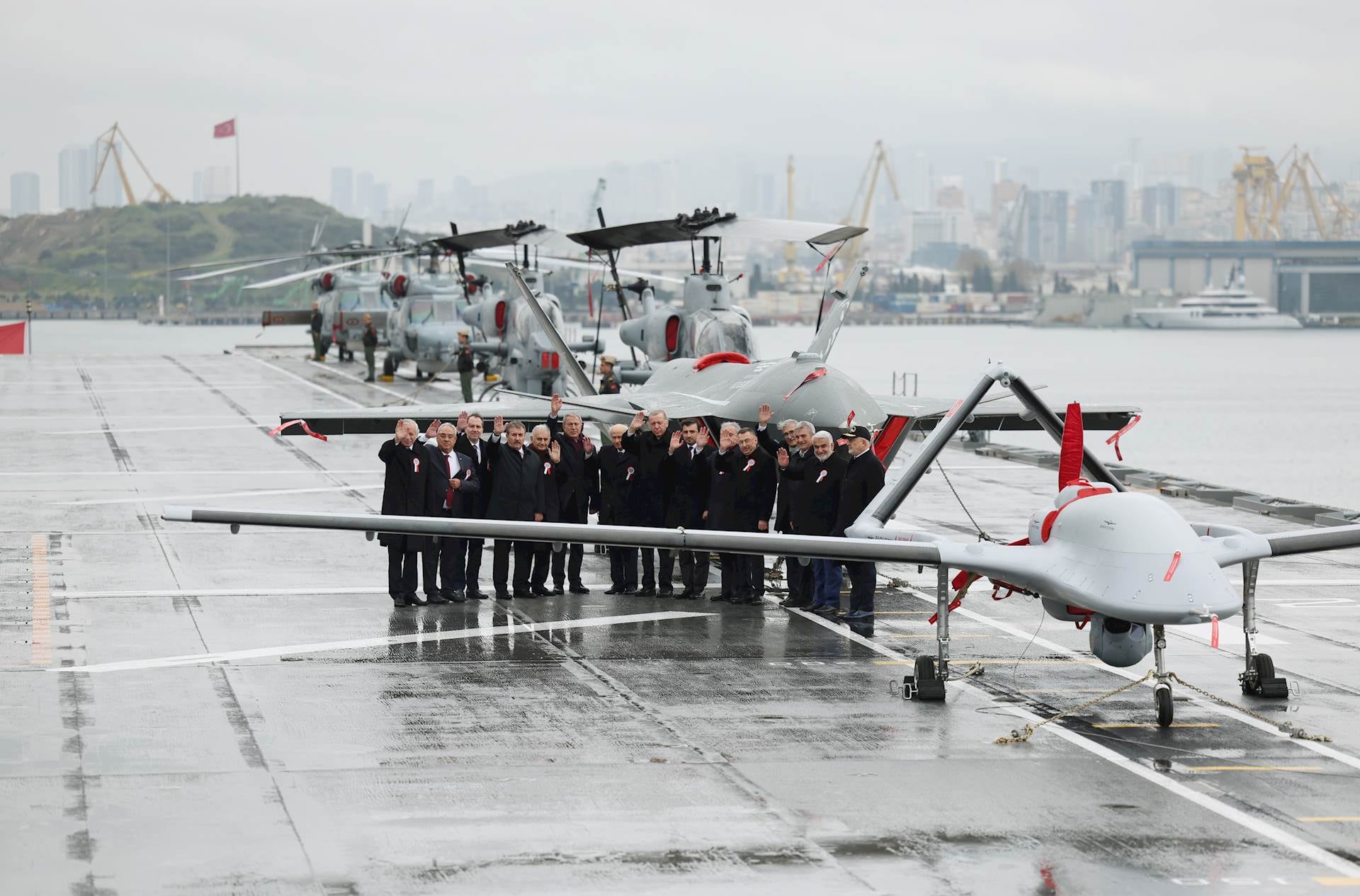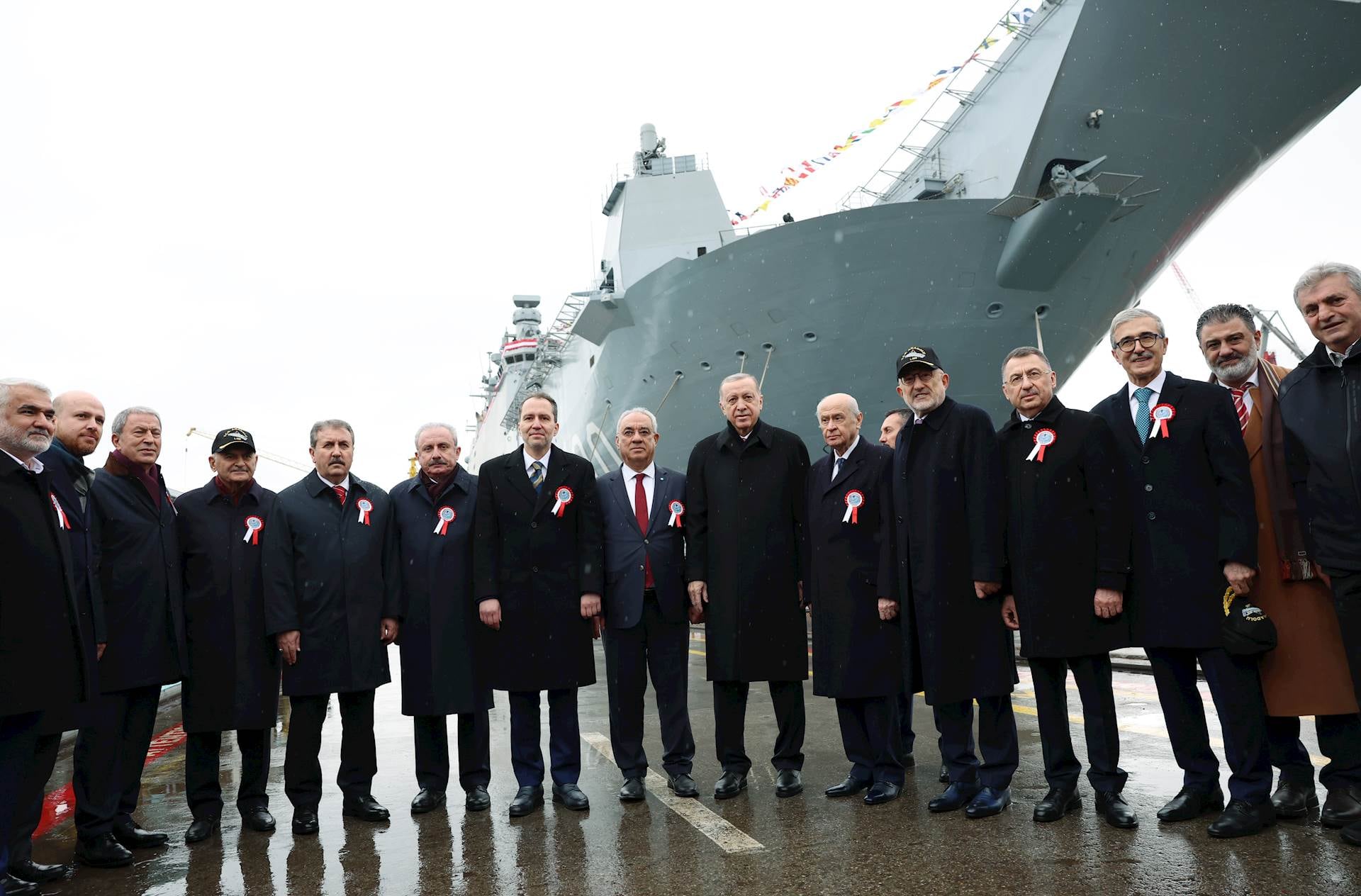ANKARA, Turkey — The Turkish Navy has received the amphibious assault ship TCG Anadolu, its largest vessel ever, from which the military will deploy heavy helicopters, drones and light-attack aircraft, according to President Recep Tayyip Erdoğan.
The service received the ship on April 10 during a ceremony attended by Erdoğan, Defence Minister Hulusi Akar and top military brass.
Its fully loaded displacement is 27,436 tons, and it measures 231 meters (758 feet) in length, 32 meters in width and 58 meters in height. The ship can carry a battalion-sized unit of 1,200 personnel, eight utility helicopters and three drones. It also can transport 150 vehicles, including battle tanks.
Specifically, the TB-3 armed drone and the Kizilelma combat UAV can launch from the ship. Both aircraft were developed and built by the privately owned Turkish drone-maker Baykar. But the government must be patient for that capability to come to fruition, according to a senior engineer supervising the program for the TCG Anadolu.

“For full operationality on the TCG Anadolu, we must have more powerful engines for the TB-2 and TB-3 drones, and develop folding-wing capabilities for the Kizilelma,” he told Defense News on the condition of anonymity because he was not authorized to speak to the media. “It will take some time before the ship becomes as operable as we wish it to be.”
Turkey selected local shipyard Sedef in 2013 for the landing platform dock, or LPD, program. The company partnered with Spain’s Navantia.
The original delivery time was five and a half years after Turkey kicked off the effort — by the end of 2021 — meaning the schedule fell behind by more than a year.
The resulting amphibious assault ship, which is based on a Spanish design, cost the Turkish government more than $1 billion, although officials have declined to reveal the exact price. Erdoğan has said the TCG Anadolu will help with military and humanitarian operations around the world.
(Geo)politics
Turkey intended to fly F-35 fighter jets from the TCG Anadolu, but the U.S. removed the country from the multinational Joint Strike Fighter program after Ankara acquired Russian-made S-400 air defense systems.
Turkey has since switched its primary aerial asset on the ship from the F-35 to the Kizilelma.
“This is not a platform suitable for fighter aircraft, except the F-35 [vertical-takeoff-and-landing] version, which Turkey would never receive. Now that Turkey’s F-35 dream is over, it will be a launching pad for drones and helicopters when they will be operationally fit for operations,” an expert with a think tank told Defense News, speaking on the condition of anonymity because of the sensitivity of the topic. “The TCG Anadolu was never meant to be an aircraft carrier. This tag became popular for propaganda purposes.”
Indeed, there could be political reasons behind the ship’s construction. One pollster told Defense News Erdogan’s campaign to provide the country with locally made defense systems — including drones, helicopters, the Altay tank, satellites and missiles — could earn the president an extra 3-4 percentage points in the national vote.
Citizens are to vote May 14 on the presidential position and lawmakers’ seats. Those points might be the kingmaker in an election that could very well end up with a 51%-49% margin.

But any gains in popularity at home likely won’t be reflected in neighboring Greece. Despite both countries holding membership in NATO, Athens considers the TCG Anadolu a threat to its sovereignty, according to Ozgur Eksi, who leads the defense-focused, Ankara-based publication TurDef.
In recent years, relations between Turkey and Greece have degraded over airspace and continental shelf disputes. Erdoğan once even threatened to launch a missile at Greece.
“Today, we call the ship [a] UAV carrier, but it is uncertain how UAVs will be piloted under heavy electronic warfare conditions,” Eksi said. “The lack of [a destroyer that can serve as a means of air defense] is another disadvantage, while [the TCG Anadolu’s] medical capabilities provide huge potential for both military and disaster-relief operations. This size ship requires establishing the protection shield at 100 miles minimum. I believe using [it] in the Aegean Sea against Greek islands is almost impossible.”
A presidential adviser said the ship’s main missions will include overseas military and humanitarian operations like those Turkey executed in Libya and Somalia in recent years.
“If needed, the ship will be used to [perform] operations off Cyprus and Syria. This vessel does not exclusively target Greece, our NATO ally,” the adviser explained on the condition of anonymity because he was not authorized to speak to the media.
Cem Devrim Yaylali, a Istanbul-based naval analyst published in several defense outlets, said one application of the new ship is force projection.
“Amphibious ships, such as the landing ship dock, landing ship platform and landing ship helicopter, are among the most versatile and multifunctional ships any navy can possess. These vessels can be considered the naval equivalent of Swiss Army knives due to their numerous potential uses,” Yaylali told Defense News. “They can carry a large number of troops, vehicles and equipment, and they can transport them directly to shore for combat operations.
“Additionally, these ships can be used to evacuate combatants and noncombatants from a conflict zone, providing a safe and secure means of transport. [The] Turkish [Navy] has much experience in this area; [it] conducted a very large noncombatants-evacuation operation from Libya in 2011. A ship such as TCG Anadolu would have solved many tactical problems with ease.”
Yaylali noted amphibious ships can also serve as command vessels for a task force, providing a central location for naval commanders to coordinate their forces.
“Furthermore, they can act as logistical supply platforms during humanitarian crises or disasters, providing necessary supplies and aid to affected areas,” Yaylali added.
Additionally, Yaylali said, the local construction of the ship benefited Turkish industry by providing technology transfer and workforce experience.
“This experience and expertise, when combined with the lessons learned from the operation of the ship, can contribute to the development of a completely indigenous amphibious assault ship and potentially create opportunities for export. The development of TCG Anadolu has also helped to enhance Turkey’s human capital in shipbuilding, particularly in the areas of design, engineering and project management,” Yaylali said.
Burak Ege Bekdil was the Turkey correspondent for Defense News.








